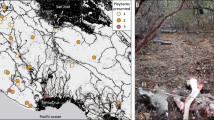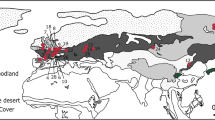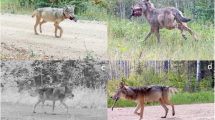Abstract
The African wild dog Lycaon pictus is critically endangered, with only about 5,000 animals remaining in the wild1. Across a range of habitats, there is a negative relationship between the densities of wild dogs and of the spotted hyaena Crocuta crocuta2. It has been suggested that this is because hyaenas act as ‘kleptoparasites’ and steal food from dogs. We have now measured the daily energy expenditure of free-ranging dogs to model the impact of kleptoparasitism on energy balance. The daily energy expenditures of six dogs, measured by the doubly labelled water technique, averaged 15.3 megajoules per day. We estimated that the instantaneous cost of hunting was twenty-five times basal metabolic rate. As hunting is energetically costly, a small loss of food to kleptoparasites has a large impact on the amount of time that dogs must hunt to achieve energy balance. They normally hunt for around 3.5 hours per day but need to increase this to 12 hours if they lose 25% of their food. This would increase their sustained metabolic scope to a physiologically unfeasible twelve times the basal metabolic rate. This may explain why there are low populations of wild dogs in regions where the risk of kleptoparasitism is high.
This is a preview of subscription content, access via your institution
Access options
Subscribe to this journal
Receive 51 print issues and online access
$199.00 per year
only $3.90 per issue
Buy this article
- Purchase on Springer Link
- Instant access to full article PDF
Prices may be subject to local taxes which are calculated during checkout

Similar content being viewed by others
References
Fanshawe, J. H. L., Frame, L. H. & Ginsberg, J. R. The wild dog — Africa's vanishing carnivore. Oryx 25, 137–146 (1991).
Creel, S. & Creel, N. M. Limitation of African wild dogs by competition with larger carnivores. Conserv. Biol. 10, 526–538 (1996).
Maddock, A. H. & Mills, M. G. L. Population characteristics of African wild dogs Lycaon pictus in the Eastern Transvaal Lowveld, South Africa, as revealed through photographic records. Biol. Conserv. 67, 57–62 (1994).
Burrows, R., Hofer, H. & East, M. Demography, extinction and intervention in a small population: the case of the Serengeti wild dogs. Proc. R. Soc. Lond. B 256, 281–292 (1994).
Fanshawe, J. H. & Fitzgibbon, C. D. Factors influencing the hunting success of an African wild dog pack. Anim. Behav. 45, 479–490 (1993).
Kruuk, H. The Spotted Hyaena: a Study of Predation and Social Behaviour. (Univ. Chicago Press, 1972).
Creel, S. & Creel, N. M. Communal hunting and pack size in African wild dogs (Lycaon pictus). Anim. Behav. 50, 1325–1339 (1995).
Mills, M. G. L. & Biggs, H. C. in Mammals as Predators, Zool. Soc. London Symp. 65(eds Dunstone, N. & Gorman, M. L.) 253–268 (Oxford Science, 1993).
Carbone, C., Du Toit, J. T. & Gordon, I. J. Feeding success in African wild dogs; does kleptoparasitism by spotted hyaenas influence hunting group size? J. Anim. Ecol. 66, 318–326 (1997).
Speakman, J. R. Doubly-Labelled Water: Theory and Practice. (Chapman and Hall, London, 1997).
Burger, I. H. & Johnson, J. V. Dogs large and small: the allometry of energy requirements within a single species. J. Nutr. 121, S18–S21 (1991).
Nagy, K. A. Field metabolic rate and food requirement scaling in mammals and birds. Ecol. Monogr. 57, 111–128 (1987).
Burger, I. H. Energy needs of companion animals: matching food intakes to requirements throughout the life cycle. J. Nutr. 124, S2584–S2593 (1994).
Hinchcliffe, K. W.et al. Metabolizable energy intake, total energy expenditure and metabolic scope of Alaskan sled dogs during prolonged exertion. FASEB J. 8, 791 (1994).
Hammond, K. A. & Diamond, J. Maximal sustained energy budgets in humans and animals. Nature 386, 457–462 (1997).
Petersen, C. C.et al. Sustained metabolic scope. Proc. Natl Acad. Sci. USA 87, 2324–2328 (1990).
Weiner, J. Metabolic constraints on mammalian energy budgets. Acta Theriol. 34, 3–35 (1989).
Kruuk, K. Wild Otters, Predation and Populations. (Oxford Univ. Press, 1995).
Kruuk, H. & Carss, D. N. in Aquatic Predators and their Prey. (eds Greenstreet, S. P. R. & Tasker, M. L.) 10–16 (Blackwell, Oxford, 1996).
Walters, L. M.et al. Repeatability of energy expenditure measurements in clinically normal dogs by use of indirect calorimetry. Am. J. Vet. Res. 54, 1881–1885 (1993).
Taylor, C. R.et al. Effect of hypothermia on heat balance during running in the African hunting dog. Am. J. Physiol. 220, 823–827 (1971).
Nagy, K. A. The Doubly Labelled Water Method: A Guide to its Use. (Univ. California, 1983).
Sheng, H. P. & Huggins, R. A. Areview of body composition studies with emphasis on total body water and fat. Am. J. Clin. Nutr. 32, 630–647 (1979).
Speakman, J. R. How should we calculate CO2production in DLW studies of animals? Funct. Ecol. 7, 746–750 (1993).
Speakman, J. R.et al. Validation of the doubly-labeled water technique in the domestic dog (Canis familiaris). Am. J. Physiol. (submitted).
Schoeller, D. A.et al. Energy expenditure by doubly labeled water: validation in humans and proposed calculation. Am. J. Physiol. 250, R823–R830 (1986).
Lifson, N. & McClintock, R. Theory of use of the turnover rates of body water for measuring energy and material balance. J. Theor. Biol. 12, 46–74 (1966).
Acknowledgements
We thank the Endangered Wildlife Trust for financial support and I. Gordon, H.Kruuk and I. Patterson for their comments on the paper. J.R.S. was supported by a Royal Society of Edinburgh Caledonian Foundation support research fellowship. We are grateful for the technical support of P. Thomson in the isotope analyses. All the DLW calculations were performed using the program written by C. Lemen and J.R.S.
Author information
Authors and Affiliations
Corresponding author
Rights and permissions
About this article
Cite this article
Gorman, M., Mills, M., Raath, J. et al. High hunting costs make African wild dogs vulnerable to kleptoparasitism by hyaenas. Nature 391, 479–481 (1998). https://doi.org/10.1038/35131
Received:
Accepted:
Issue Date:
DOI: https://doi.org/10.1038/35131
This article is cited by
-
Advances in biologging can identify nuanced energetic costs and gains in predators
Movement Ecology (2024)
-
An extraordinary fossil captures the struggle for existence during the Mesozoic
Scientific Reports (2023)
-
The current state of carnivore cognition
Animal Cognition (2023)
-
African wild dog movements show contrasting responses to long and short term risk of encountering lions: analysis using dynamic Brownian bridge movement models
Movement Ecology (2022)
-
Priority of access to food and its influence on social dynamics of an endangered carnivore
Behavioral Ecology and Sociobiology (2022)
Comments
By submitting a comment you agree to abide by our Terms and Community Guidelines. If you find something abusive or that does not comply with our terms or guidelines please flag it as inappropriate.



